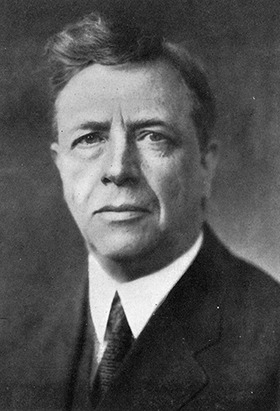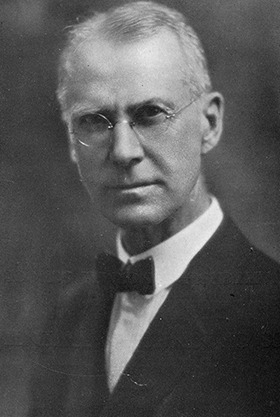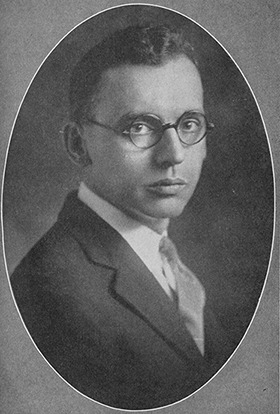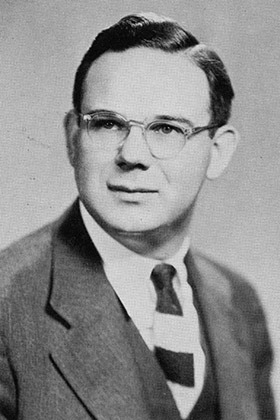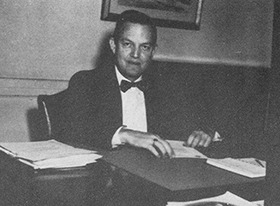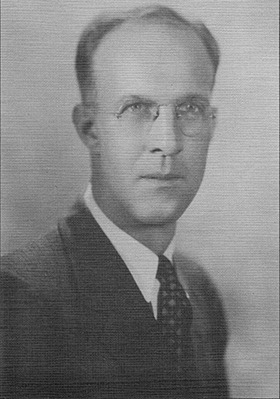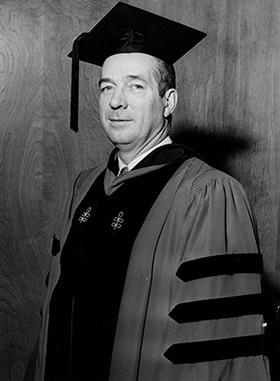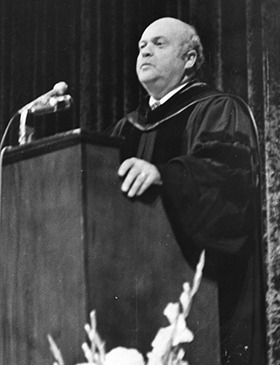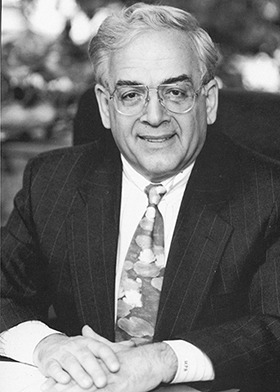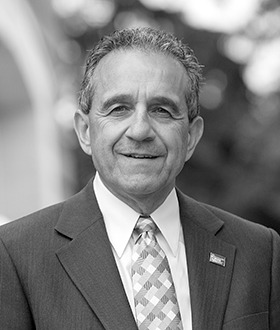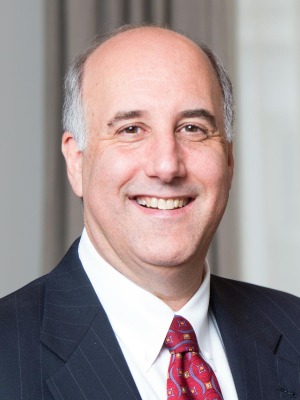John G. Thompson
(1895-1920)
The Fitchburg Normal School was founded in 1894 and located on Academy Street. Its first principal, as the chief officer of the institution was then known, was John G. Thompson.
Throughout his tenure, Thompson was responsible for establishing the first building on the campus as we know it, which bears the name Thompson Hall in his honor. He also selected the first crop of professors, which established an institutional standard of excellence in faculty that continues.
Thompson knew the success of the normal school’s students was paramount in broadening the institution’s appeal in other areas of the Commonwealth. He, along with the superintendent of the Fitchburg Public Schools, Joseph Edgerly, sought a model school on campus as a way to give teachers-in-training a hands-on environment. The building known today as Edgerly Hall was originally a middle school that provided a way for students to observe and practice.
The Normal School’s earliest years were prosperous in a way that expedited a need for more physical and academic expansion. Thompson oversaw the implementation of the first on-campus dormitory, Miller Hall, and the initial programs were re-organized and refined. New programs were added, including areas of study for young men that were added to the curriculum beginning in the 1910-1911 school year.
It was important for the Fitchburg Normal School to have a leader who could adapt to the community’s ever-changing needs. Thompson sought to make student life robust and palatable. He attracted a host of guest lecturers, artists and performers to campus and installed the earliest sports programs—men and women’s basketball—as a means of curating a vibrant institution.
William D. Parkinson
(1920-1927)
William Dwight Parkinson came to the Fitchburg Normal School from the State Department of Education where he served as agent in-charge of vocational teacher training. Although he was 63 years old at the time he assumed the role of principal, his service was energetic and passionate.
Parkinson wanted to project a broader image for the school. Ever conscious of public perception, he made changes to the course catalogue in order to ensure course descriptions were concise, digestible, and more closely resembled those of larger institutions.
There was a desire to strengthen the academic progress even further. Parkinson sought the advice of his faculty as to which programs could be supported with the school’s existing resources, which resulted in the following programs:
- A two-year elementary program
- A three-year junior high program
- A three-year practical arts program
- A one-year program for college graduates
- A four-year degree program including a year of academic studies
His background may have been in academia, but Parkinson proved he was equally adept at other facets of the student experience. The Fitchburg Normal School was at the time focused on preparing students for education careers and was decidedly short on social clubs and extra-curricular activates. As such, Parkinson encouraged the development of groups that were of interest to normal school students, materializing first in the Gaveleer Literary Society, the Debating Council and the Glee Club.
As the school grew in scope and size, Parkinson recognized the need for additional space. He proposed the purchase of additional land to support the growing spectrum of campus activities: hiking, basketball, crew, tennis and bowling.
Parkinson’s tenure was dedicated to the analysis of current programs, implementing new ones and positioning Fitchburg Normal School for a prosperous future. The students agreed that he served them well, as they wrote the following of him in the student publication Saxifrage:
“His inexhaustible patience and his active interest in all student activities have done much for us and for the advancement of our school.”
Dr. Charles M. Herlihy
(1927-1945)
Charles Michael Herlihy joined the Fitchburg Normal School after serving as assistant supervisor of Americanization for the State Board of Education for seven years. At 34, he became the youngest normal school principal in the state of Massachusetts.
Herlihy wanted to keep the school competitive and attractive to students. He cited the importance of national trends in order to remain relevant and competitive, beginning with the implementation of four-year programs in order to become a more viable destination for wider academic audiences.
New programs broadened curricular approaches, but Herlihy wanted to further distinguish the Fitchburg Normal School from its sister institutions and recognized the industrial arts program as a viable way to do that. There was a rising economic need for these jobs, and he invested in new facilities to host a program already well known throughout the country as one of the best. He also opened it up to women and encouraged their enrollment.
Significant name changes occurred during Herlihy’s tenure. In 1932 he became the University’s first chief executive to go from “principal” to “president”. This was a result of a state-triggered name change that required all normal schools be transformed into teachers colleges, turning Fitchburg Normal School into Fitchburg State Teachers College.
In 1943, Herlihy committed the College to a cooperative nursing education program with Burbank Hospital. Students in the program were provided collegiate level courses in sciences and other academic disciplines and were able to earn their degrees in five academic years.
Throughout his nearly 20-year tenure, Herlihy remained a dedicated leader who steered the institution forward with effective initiatives and programs, some of which remain in place today.
Dr. William J. Sanders
(1945-1950)
Dr. William James Sanders was professor of education and director of extension at the State Teachers College in New Haven, Connecticut when he was appointed by the State Board of Education to be the newest president of Fitchburg State Teachers College.
The boom in college attendance following World War II created a national teacher shortage. Sanders recognized this would significantly impact the industrial arts arena, as potential teachers had been siphoned off into military service or war production industries, leaving a market for qualified candidates. With a successful program in place, he knew the Fitchburg State Teachers College was well positioned to capitalized on this.
Sanders sought to accommodate the phalanx of veterans looking at higher education after the war. The institution installed challenging but flexible programs that would benefit their transition from soldiers to job seekers. He also made sure the campus provided comfortable and affordable housing for its veteran population, and encouraged the creation of a veterans club that would serve as a center for peer support.
Other student organizations were formed during this time as well. A women’s club that attempted to forge a stronger connection between dormitory women and commuter women, for example, and the Student Christian Fellowship Club, which came at the behest of students looking to foster their spiritual and social well beings.
Sanders grew the institution’s liberal arts content, allowing students to receive a well-rounded education in arts, sciences and humanities in order to support their personal and intellectual development toward a leadership role in society.
President Sanders sewed the seeds of the institution’s future success with a campaign to obtain a new gymnasium, his recruitment of talented faculty members and a focus on student recruitment and selection to ensure a prosperous way forward.
Dr. Ellis F. White
(1950-1953)
Dr. Ellis F. White was appointed college president in 1950 and he immediately moved to make the institution more transparent. To do so, he initiated a comprehensive public relations program that would candidly explain the institution’s needs and goals to the general public in a way that he believed would benefit all statewide teachers colleges.
He encouraged the faculty to be more involved in the school’s issues, and sought their input on a variety of matters, paramount among them being the school’s regional accreditation.
Though his tenure as president was brief, White showed concern for the institution’s students at every turn. He brought a qualified psychiatrist to campus in order to confer with students in need of such counseling. Dr. White also kicked off initial conversations regarding the construction of new facilities that would happen after he left.
Over its first 50 years, the campus incurred expected amounts of cosmetic wear and tear, some of which had to be ignored throughout leaner years such as the Great Depression era. But White was able to secure funds that would be put toward repairing and modernizing the campus alongside the planned expansions. As a lasting mark, the State College at Fitchburg reinforced a sense of community for its students, faculty, and staff, where everyone had a say in the school’s future.
Dr. Ralph F. Weston
(1953-1962)
Dr. Ralph F. Weston was appointed acting president for an interim period late in 1953, and was selected as the institution’s sixth president just six months later.
Weston wanted to achieve accreditation for the school’s nursing program. To do this he needed the approval of the National League of Nursing, who would agree if some sweeping changes were implemented. Weston was eager to accommodate, bringing on a full time program administrator (tasks that were previously handled by Burbank Hospital). He also sought legislature that would provide the college with six more nursing positions.
As enrollment grew, Weston stressed the importance of meeting the needs of its academic audience. He guided the institution as it continued to expand its course offerings, recognizing the strain that rising enrollment placed on the existing facilities. Weston was able to secure funding for the construction of a library, administrative, and classroom building, which offered new laboratories and lecture halls, an auditorium and office space.
Weston steered a modest and moderate course, empowering faculty and staff with increased responsibility while he focused on the improvement of training schools, management of budgets and continued academic strength.
James J. Hammond
(1962-1975)
James J. Hammond Sr. was a towering figure who presided over transformative times in the University’s history, a time buoyed by rapid growth and evolution.
The projects brought to fruition under his watch include:
- The construction of the industrial arts and fine arts building that would later be named in memory of Florence Conlon
- the expansion of the dining hall that now spans North Street
- Construction of the dormitory that was later named Russell Towers
- The library and campus center which bears his name
- The acquisition of land off Pearl Hill Road for the college’s athletic fields
Also, the building of a new teacher training center that would include a public city school – currently known as the McKay School – would propel Fitchburg State forward. Enrollment more than doubled during his tenure, and Hammond pushed for major investments in technology and media.
Hammond’s presidency also oversaw changes to the institution’s structure of governance, from creating the positions of Dean of Students and Director of Admissions to the formation of the All College Council, which included student, faculty and administrative representatives. Hammond had long believed every faculty member should have a voice in the academic and professional affairs of the institution.
Curricular changes included an investment in liberal arts to implement broadened degree-granting powers that came with the name change to Fitchburg State College in 1960. Hammond also forged strong ties with industry.
During the unrest of the Vietnam era and the protests concerning the draft, Hammond discussed the anguish felt by students and faculty in a letter he wrote to President Richard M. Nixon on May 11, 1970:
“Taxation without representation has been indefensible in our nation’s history,” he wrote. “Conscription without representation, not only in an undeclared war, but in an extended theatre of action, seems inconsistent with our constitutional guarantees as a people. No action of the government must ever raise doubts about those basic ideals for which America has stood and by which every school child has been inspired. Any cause for disillusionment will result in a loss of confidence and a consequent withering of the common spirit of Americans. College campuses reflect a cancerous affliction caused by a lack of trust in or identification with the basic principles of America.”
Dr. Vincent J. Mara
(1976-1995)
Vincent J. Mara, Fitchburg State’s eighth president, had several roles in academia before accepting the role of president at Fitchburg. He built upon previous leadership advances in terms of transparency while ushering the school into the modern era.
Mara’s open door policy took the form of regular office hours that allowed students to reach him for any number of issues.
He was also known to host social dinners at his house, inviting department chairmen, academic departments and student groups to discuss institutional business and campus life. He held weekly meetings with principal staff in order to stay abreast of issues and chart the progress of various initiatives.
The culmination of Mara’s open door outlook was “Assessment Week,” which occupied a full week in April. The event invited faculty, staff and students to attend a number of seminars in order to evaluate the college’s current status and to consider the path it should follow in the years ahead.
Initiatives for improvement were undertaken on a half dozen fronts: academic growth was signaled through strengthened curricula, new programs, and extended accreditations. Student development was improved through expanded services and augmented financial aid. New buildings and renovations enriched campus life, and Mara sought increased alumni participation. He developed a president’s team to maximize efficiency and ensure that the institution’s strategies were being met while strengthening the school’s community involvement with faculty that performed needed services.
Mara’s 19 years as president offered considerable and rounded achievement for the institution. His insistence on high-level performance from his staff members, as well as his day-to-day checking of academic, fiscal, student and building projects illustrated a grasp on the essentials of leadership that steered the institution through nearly two decades of growth.
Dr. Michael P. Riccards
(1995-2002)
Michael P. Riccards brought Fitchburg State into the 21st century literally and figuratively.
The implementation of the first campus-wide Internet network was the first step in creating a technology infrastructure that would grow and evolve. As the campus continued its modernization, Riccards oversaw several improvements to the North Street corridor through a close working relationship with the City of Fitchburg—ongoing cooperation that continues today.
The North Street plan included the construction of a new recreation center. Ground was broken in April 1996 to create the building that would replace Parkinson Gymnasium and better serve the needs of a campus of 3,700 students. The building’s grand opening was held in September 2000. He also secured the initial financial pledge from the state of Massachusetts to build a science and technology center on campus, which later became the Antonucci Science complex.
He retired from Fitchburg State to become the public policy scholar-in-residence at the College Board in Washington, D.C.
Dr. Robert V. Antonucci
(2003-2015)
Dr. Robert V. Antonucci, a lifelong educator widely recognized for his expertise in all facets of public education, is president emeritus of Fitchburg State University.
His record of success at Fitchburg State includes:
- The drafting of a new strategic plan
- Completion of a record-setting capital campaign
- Construction of a new science complex
- Renovation of the campus center, library and dining commons
- Conversion of the University's outdoor athletic facilities into a professional-level stadium
- Establishment of a Faculty Teaching Center
- The acquisition of several neighborhood buildings that were refashioned for use as university offices, residence halls or green space
He also embarked on an ambitious series of technology initiatives, including:
- Establishment of a “wireless” campus
- A total upgrade of computer laboratories
- The creation of dozens of new classrooms that allow faculty access to the most advanced teaching tools
From his first days in office, Antonucci worked to strengthen the University’s commitment to its host city. Creating an attractive boulevard connecting the University’s central artery, North Street, with the city’s Main Street was a multi-year effort. The process was accelerated with the purchase of several distressed properties, construction of a new campus police station, and relocation of campus offices.
At the city’s request, the University also assumed control of the Wallace Civic Center and renovated the aging arena into one of the best such facilities in the region. The closing of a former public street that ran through the University and its conversion into a tree-lined plaza increased safety and allowed a number of residence halls to be connected to the main campus. In an effort to provide additional academic space, Antonucci worked with the University’s foundation to purchase an off-campus building that now houses many of the institution’s auxiliary services.
Antonucci significantly increased the University’s visibility in Boston as well as the local region, serving on countless community initiatives and working closely with elected leaders. Governor Deval Patrick appointed him to co-chair the Higher Education Task Force and to serve as a member of the Pre-K through 12 Task Force. Subsequently he was appointed by the governor to chair the University of Massachusetts and Public Higher Education subcommittee of the Readiness Project Leadership Council. He was also chosen to serve as a member of the Workforce Standards and Performance Accountability Task Force.
As education commissioner in the 1990s, Antonucci played a key role in the passage and enactment of the state's historic Education Reform Act of 1993, a landmark law now seen as a national model. Throughout his tenure, Antonucci’s celebration of Fitchburg State as “the #1 state university” was ceaseless, and successful in boosting institutional pride among students, faculty and staff.
Dr. Richard S. Lapidus
(2015-2024)
Dr. Richard S. Lapidus, a recognized leader in higher education, took office as the 11th president of Fitchburg State University in July 2015. A product of public education, he has long been an advocate for increased access and affordability for higher education. His tenure focused on advancing teaching and learning excellence, fostering diversity and inclusiveness, and engaging the campus community as a steward of place within the city and region.
During his tenure he invested in student success through the establishment of a First Year Experience course, designed to help establish a students’ sense of campus community and strengthen their connection to both their discipline and the institution.
Lapidus also initiated the Student Success Collaborative on campus, launching a program that provides longitudinal tracking of student performance and the sharing of performance data to allow for more intrusive intervention when needed to redirect students that are straying-off course.
Among other capital projects, Lapidus oversaw the redevelopment of Landry Arena at the Wallace Civic Center into a strength and conditioning lab and indoor training facility. A collaboration between the Athletics Department and the Sports and Exercise Science academic department, this is a state-of-the-art training facility for student athletes and an applied working laboratory for students.
Lapidus also established the entrepreneurship center known as the ideaLab at the Main Street theater block that the University purchased in 2016. This interdisciplinary facility located off-campus is designed to promote applied work and create interaction between students, faculty and working professionals.
Programmatically, Lapidus guided the launch of three fully on-line accelerated graduate programs. These programs are targeted at working professionals in the areas of business, nursing and education.
Dr. Donna Hodge (2024-)
Dr. Donna Hodge serves as the 12th President of Fitchburg State University and is the first woman to hold this prestigious position. With over two decades of experience in higher education leadership, strategy, and operations, Dr. Hodge brings a wealth of knowledge and expertise to her role.
Before joining Fitchburg State, Dr. Hodge was the Vice President of Operations and Advancement at Colorado State University Pueblo (CSU Pueblo), a public university serving 4,000 students, many from minoritized and low-income backgrounds. She was instrumental in driving CSU Pueblo's #VISION2028 strategic plan, a transformative $19 million initiative aimed at establishing the university as a regional hub of innovation, education, and community engagement.
In her capacity as Vice President, Dr. Hodge oversaw all facilities, auxiliary enterprises, marketing, communications, HSI grants, and advancement functions. She managed budgets exceeding $100 million, including E&G, Auxiliary Services, Capital Construction, facilities recharge, and all federal Title V programs. Additionally, she led a cross-functional team of over 140 internal and external stakeholders and played a crucial role in securing and administering more than $22 million in federal and state grants to support the university's mission and programs.
Dr. Hodge is deeply committed to creating opportunities and solutions for underrepresented communities. Her exceptional work in this area has been recognized by the American Association of State Colleges and Universities (AASCU), which honored her with the 2021 Excellence and Innovation award.
Dr. Hodge holds a Ph.D. in Rhetoric, Master's degrees in English and Women's Studies, and executive certificates from MIT and Harvard. Her academic and professional achievements underscore her dedication to advancing higher education and fostering inclusive environments for all students.
As President of Fitchburg State University, Dr. Hodge is poised to lead the institution into a new era of growth, innovation, and community engagement.
